|
|
|
 |
Roundtable on Ectoplasm and Materialization Continues (Part 3)
Posted on 21 December 2020, 10:51
A virtual roundtable involving four pioneers of psychical research on the subjects of ectoplasm and materialization began with my post of November 23, while Part 2 was posted on December 7. This is the final part. The roundtable members are Sir Williams Crookes, Professor Charles Richet, Dr. Gustave Geley, and Dr. Albert von Schrenck-Notzing, all identified in the first post. I am serving as moderator.
As stated in Part 1, the words here are those of the researchers, as extracted from their reports and books, except words in brackets, which are inferred to permit a meaningful flow and link.
Moderator: I am pleased to announce that Dr. William J. Crawford is in town and will be joining us for this final session. I know that you are all familiar with his work, but for the benefit of the audience, I will note that Dr. Crawford has done extensive research with mediums. He was a lecturer in mechanical engineering at Queen’s University of Belfast and the Municipal Technical Institute of Belfast. Beginning in 1914, he had 87 sittings with the Goligher Circle over a period of some two-and-a-half years, resulting in four books – The Reality of Psychic Phenomena (1918), Hints and Observations on the Phenomena of Spiritualism (1918), Experiments in Psychical Science (1919), and The Psychic Structure of the Goligher Circle (1921) (The other four welcomed Dr. Crawford)
I’d like to begin by asking Dr. Crawford to summarize his experiences with ectoplasm, although I realize he referred to it simply as plasma. It is my understanding, Dr. Crawford, that you did not actually visualize the plasma or ectoplasm until the very end of your research.
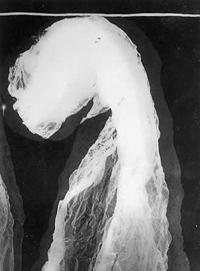
Crawford: “[My pleasure.] On one occasion, while the table was levitated I placed my hand under it near the top. As in previous tests, I felt no sense of pressure whatever, but I did feel a clammy, cold, almost oily sensation – in fact, an indescribable sensation, as though the air there were mixed with particles of dead and disagreeable matter. Perhaps the best word to describe the feeling is ‘reptilian.’ I have felt the same substance often – and I think it is substance – in the vicinity of the medium, but there it has appeared to me to be moving outwards from her. Once felt, the experimenter always recognizes it again. This was the only occasion on which I have felt it under the levitated table, though perhaps it is always there, but not usually in such intense form. Its presence under the table and also in the vicinity of the medium shows that it has something to do with the levitation; and in short I think there can be little doubt that it is actual matter temporarily taken from the medium’s body and put back at the end of the séance, and that it is the basic principle underlying the transmission of psychic force. The table soon dropped when I moved my hand to and fro in amongst this psychic stuff.”
Moderator: You wrote of observing all this under a red light. However, it is somewhat unclear as to what you actually witnessed.
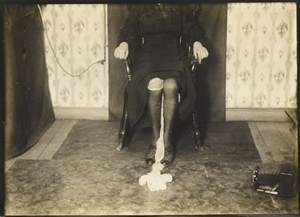
Crawford: “The light is usually strong enough – after the eyes get accustomed to its red color – to see quite plainly all the sitters. It is a subdued kind of light, issuing from a large surface of ordinary gas flame. The only difficulty in the visibility is where a table or other large body casts a shadow over a portion of the floor … The greatest trouble experienced by the experimenter in tracing the outlines of the psychic structures at the Goligher circle lies in the fact they are generally quite invisible under the ordinary conditions of the séance room. They are not always quite invisible, but usually so.”
Moderator: You mentioned not being able to take photographs until the final stages of your research.
Crawford: [“True.] Only within the last six months or so has it been found possible to photograph the stuff which issues from the medium’s body – I call it ‘plasma’ for want of a better word – and from which the psychic structures are built up that produce the phenomena of raps, levitations, touchings, etc. … The operators informed me by raps that success would finally come if I would be persistent enough. The chief difficulty seemed to be in preventing injury to the medium. The operators said it was necessary gradually to work her up to withstand the shock of the flashlight upon the plasma; nor is this much to be wondered at when it is considered the plasma is part of her body exteriorized in space.”
Moderator: Thank you, Dr. Crawford. I would like to devote the remainder of this last session to the concern as to what is behind all this strange activity. Sir William, since your research preceded that of the others here, I’d ask to begin with you.
Crookes: “Without wishing at present to speak positively on this point, I may say that whilst I have observed many circumstances which appear to show that the will and intelligence of the medium have much to do with the phenomena, I have observed some circumstances which seem conclusively to point to the agency of an outside intelligence, not belonging to any human being in the room.”
Richet: “[Let’s call it what it is.] We have come to the spiritist hypothesis. It is neither to be desired nor feared. When we devote ourselves to the high task of seeking truth, we ought not to be intimidated by the opinion of the crowd, nor allured by any obscure desire for personal immortality … The hypothesis is frank and clear. By conferring omniscience on spirits it explains most of the facts, but it involves so many improbabilities that, despite its seeming simplicity, I find myself unable to adopt it. Nevertheless I oppose it half-heartedly, for I am quite unable to bring forward any wholly satisfactory counter-theory.”
Schrenck-Notzing: “[I believe] that the spirit hypothesis not only fails to explain the slightest detail of these occurrences, but it impedes and hinders in every way serious scientific investigation … Nearly all the investigators who have lately studied the phenomena of physical mediumship – which, in view of the psychogenic character of the occurrences, must always retain some connection with psychical phenomena – incline towards a rejection of the spiritistic theory in favour of the psycho-dynamical conception and towards a purely observational attitude.”
Moderator: Dr. Geley, your thoughts or position?
Geley: “It should be beyond doubt that the Self both pre-exists, and that it survives the grouping which it directs during one’s earth life; that it more particularly survives its lower objectifaction during this life. This may at least be admitted, if not as a mathematical certainty, at least as a high probability. If so, the manifestation of a ‘discarnate spirit’ on the material plane by the aid of dynamic and organic elements borrowed from the medium then appears an undeniable possibility.”
Moderator: Dr. Crawford, in your reports, you refer to “operators” on the other side communicating with you in carrying out your experiments. Do you see these operators as spirits of the “dead” or some aspect of the subconscious?
Crawford: “[The subconscious] is the alternative I had in mind all through my investigations. As months succeeded month, as each new phase of phenomena was presented, as each new experiment was done, I always said to myself, ‘Can this very determined work of seemingly intelligent beings be but a simulation after all? Can it be all a fraud? Is it possible that nature holds intelligences belonging to ourselves or otherwise, which could so persistently deceive? Why should our subliminal consciousness (supposing we possess such a thing) carry out for us phenomenal demonstrations on the lines of reason and intelligence, requiring effort and system, for the object of deceiving us?’ No! It seems most unlikely and repellant to our sense of the fitness of things. Nobody who has not delved deeply into psychic phenomena can have any conception of its tremendous variety and range. It includes telekinetic phenomena, apports, materialization, the direct voice, clairvoyance, clairaudience, trance, etc., etc. There are, in fact, dozens of phases of psychic action, all consistent in the inference to which they lead, namely, that man survives death, and inconsistent on any other hypothesis.”
Moderator: Some critics have a difficult time believing that spirits would be engaged in what seems to them as tomfoolery. As I understand it from your reports, they are experimenting, just as you are? What do you say to this?
Crawford: “I admit that it is very difficult for the ordinary person to bring home to his consciousness the fact that these unseen beings can possibly be like himself in their make-up. There is an ingrained feeling in humanity that the beings inhabiting the after-death world must be far removed from us in mental qualities and characteristics – we feel that they should a great advance in intellectual equipment over what they possessed here; that they should be, if not quite angels, at any rate not far removed from them. Of course this instinctive feeling we all possess is due to centuries of religious instruction behind us; we feel that the next state must of necessity be either heaven or hell. Hence it is rather a shock to us when we find the inhabitants of that other state not to be angels by any manner of means, not to exceed us appreciably in intelligence, but to be, in fact, only good-natured beings of much the same capacity as our familiar selves.”
Moderator: Did the operators tell you anything about their living conditions?
Crawford: “The entities communicating say that the next state is not a homogeneous whole, but that it is built up of ‘spheres’ and ‘realms,” and that they themselves do not all belong to one sphere. Entities belonging to a higher sphere may come down at will to a lower, but not vice versa … The first sphere would seem to be the abode of people whose moral development was somewhat low as they passed from things terrestrial; who need a lot of cleaning up before they can rise into the second and higher spheres; in other words, the spheres next the earth are the abode of the riff-raff of humanity. The entities tell me that all our experimental circles are guarded very strictly on their side so that no undesirable shall be able to get near. As a matter of fact I would not care to be in the Belfast séance room if I had any doubt of the beneficent intentions of those behind the scenes.”
Moderator: Did they ever tell you why they are interested in demonstrating at these séances?
Crawford: “[Yes.] Their answer to this is that the mere fact of being engaged in producing the phenomena and thus doing useful work helps them in their own development. For this and for other reasons I have rather come to the conclusion that one of the central ideas underlying the activities of the next state is that of service.”
Moderator: Outside of the operators, are other spirits aware of what is going on?
Crawford: “According to the operators the people on their side are somewhat curious about psychic phenomena. I have often asked them if there were many looking on at our séances. Whenever asked the questions they would begin rapping and keep on rapping until we were tired of hearing them. They wished to indicate by this that there were great crowds of spirit people looking on. They told me this was the case at all our séances. They gave me the impression that the séance room and the sitters were surrounded by a huge invisible audience arranged in an orderly and disciplinary manner, perhaps tier upon tier as in a lecture theater. The séance to many of them would appear to be as novel as it is to us.”
Moderator: Dr. Geley, I can see you want to add something.
Geley: “For my own part, if I may give a personal impression of what I have observed in the domain of mediumship, I should say that even if in a given case spiritist intervention could not be affirmed as a scientific certainty, one is obliged, willingly or unwillingly and on the aggregate of cases, to admit the possibility of such intervention. I think it is probable that there is, in mediumship, an action of intelligent entities distinct from the medium. I base this opinion not only on the alleged proofs of identity given by the communicators, which may be matters of controversy, but on the high and complex phenomena of mediumship. These frequently show direction and intention which cannot, unless very arbitrarily be referred to the medium or the experimenters. We do not find this direction and intelligence either in the normal consciousness of the medium, nor in his somnambulistic consciousness, nor in his impressions, his desires, or his fears, whether direct, indirect, suggested, or voluntary. We can neither produce the phenomena nor modify them. All happens as though the directing intelligence were independent and autonomous. Even this is not all. This directing intelligence seems to be deeply aware of much that we do not know; it can distinguish between the essence of things and their representations; it knows these sufficiently to be able to modify as its will the relations which normally govern these representations in space and time. In a word, the higher phenomena of mediumship seem to indicate, to necessitate, and to proclaim direction, knowledge and abilities which surpass the powers – even the subconscious powers – of the mediums.”
Moderator: Sir William, as the senior person here, would you like to wrap it up?
Crookes: “In old Egyptian days, a well-known inscription was carved over the portal of the temple of Isis: ‘I am whatever hath been, is, or ever will be; and my veil no man hath yet lifted.’ Not thus do modern seekers after truth confront Nature – the word that stands for the baffling mysteries of the Universe. Steadily, unflinchingly, we strive to pierce the inmost heart of Nature, from what she is to re-construct what she has been, and to prophesy what she yet shall be. Veil after veil we have lifted, and her face grows more beautiful, august, and wonderful, with every barrier that is withdrawn.”
Michael Tymn is the author of The Afterlife Revealed: What Happens After We Die, Resurrecting Leonora Piper: How Science Discovered the Afterlife, and Dead Men Talking: Afterlife Communication from World War I.
His forthcoming book, No One Really Dies: 25 Reasons to Believe in an Afterlife is released on January 26, 2021.
Read comments or post one of your own
|
 |
Roundtable on Ectoplasm and Materialization Continues (Part 2)
Posted on 07 December 2020, 11:39
A virtual roundtable involving four pioneers of psychical research on the subjects of ectoplasm and materialization began with the last blog post here on November 23. It continues here and will conclude on December 21. The roundtable members are Sir Williams Crookes, Professor Charles Richet, Dr. Gustave Geley, (below) and Dr. Albert von Schrenck-Notzing, all identified in the prior post. I am serving as moderator.
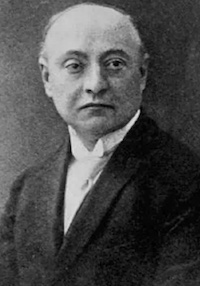
As stated in Part 1, the words here are those of the researchers, as extracted from their reports and books, except words in brackets, which are inferred to permit a meaningful flow and link.
Moderator: Gentlemen, before the break, you discussed the nature of ectoplasm, how it takes on different forms, from a vapor to a thick milky paste, and how materialized objects take shape from or within the ectoplasm, sometimes forming just hands or faces and occasionally a full body.
Richet: [“Correct.] The outcome of these surprising observations is that we can state the stages in the formation of ectoplasms – a whitish steam, perhaps luminous, taking the shape of gauze or muslin, in which there develops a hand or an arm that gradually gains consistency. The ectoplasm makes personal movements. It creeps, rises from the ground, and puts forth tentacles like an amoeba. It is not always connected with the body of the medium but usually emanates from her, and is connected with her.”
Moderator: “Thank you, Professor Richet. To begin this session, I would like to ask why the so-called cabinet is necessary in the first place. It is my understanding that these cabinets are mostly curtained-off sections of the room.
Geley: “This dark cabinet has no other purpose than to protect the sleeping medium from disturbing influences, and especially from the action of light. It is thus possible to keep the séance-room sufficiently well lit for perfect observation.”
Schrenck-Notzing: “According to the spiritistic view, the closed cabinet opposes the dispersion of the fluid emanating from the medium. For the carping critic, the cabinet, the darkness of the reduced light, only exist in order to hide the manipulations by means of which the phenomena are fraudulently produced. That this easily understood view is generally applauded is not surprising.”
Moderator: But why darkness in the first place?
Richet: “For one reason or another, none, or scarcely any, are produced in full light. This does not apply to D. D. Home who gave astonishing materializations in the light; but in most cases darkness is essential. Sometimes red light, such as used by photographers, can be used and when the medium is very powerful, flashlight photographs can be taken. Nevertheless, darkness is usually so necessary that the medium must be protected by a curtain (forming a cabinet), notably at the beginnings of the phenomena. Only behind this curtain, even when the room is darkened, can preliminary changes take place. This will cause skeptics to smile; but in point of fact what does darkness matter? Can darkness create a living face and produce a white veil?”
Crookes: “I have said that darkness is not essential. It is, however, a well-ascertained fact that when the force is weak a bright light exerts an interfering action on some of the phenomena. The power possessed by Mr. Home is sufficiently strong to withstand this antagonistic influence.”
Geley: “The detrimental action of light on ectoplasmic forms is not surprising. Light is well known to be fatal to many micro-organisms, and seems to hinder the organization of primordial forms of life.”
Schrenck-Notzing: “The recent investigations by W. J. Crawford have shown that white light acts destructively on the pseudopods or psychic projections from the medium’s body necessary for the production of telekinetic phenomena. It appears to produce a molecular softening of the invisible ‘rods’; while red light acts much more feebly. It is, therefore, necessary to consider the reflection, refraction and absorption of the light used in the séance room … All [my] observations agree in this, that a white light has a hindering and disturbing effect on the phenomena, and an unfavorable action on the development of the teleplasm.”
Moderator: If I understand all this correctly, mediums vary in power and the ability to produce phenomena as well as to resist light depends on that power. Mr. Home must have been an exceptionally powerful medium to be able to produce in good light.
Crookes: “I may at once answer one objection which has been made in several quarters, viz., that my results would carry more weight had they been tried a greater number of times, and with persons, and with other persons besides Mr. Home. The fact is, I have been working at the subject for two years, and have found nine or ten different persons who possess psychic power in more or less degree; but its development in Mr. D. D. Home is so powerful, that, having satisfied myself by careful experiments that the phenomena observed were genuine, I have, merely as a matter of convenience, carried on my experiments with him, in preference to working with others in whom the power existed in a less striking degree.”
Schrenck-Notzing: “The exhaustion of the medium is, as a rule, in proportion to the strength of the phenomena. But the effort involved in the action of the medium’s organism is much greater when the audience is unfavorable. Occasionally, the mood of the medium may be adversely affected by unsympathetic personalities, or by contemptuous treatment.”
Geley: “A light, especially if sudden and unexpected, produces a painful start in the medium. However, nothing is more variable than the light-effects; in some cases the substance can stand even full daylight. The magnesium flashlight causes a violent start in the medium, but it is borne, and allows of instantaneous photographs. In the effects of light on the substance, and its repercussion on the medium, it is difficult to distinguish between real pain and mere reflex; both, whether pain or reflex, impede investigation.”
Moderator: I understand that the medium experiences much pain as the ectoplasm is being exuded from her or his body.
Geley: (Referring to the medium known as Eva C.) “The phenomena appear (when they do appear) after a variable interval, sometimes very brief, sometimes an hour or more. They always begin by painful sensations in the medium; she sighs and moans from time to time much like a woman in childbirth. These moans reach their height just when the manifestation begins, they lessen or cease when the forms are complete.”
Moderator: Does the ectoplasm usually flow from the mouth?
Geley: “The most frequent and most easily observed origin is from the mouth; the substance is then seen to proceed from the interior surfaces of the cheeks, the roof of the palate, and the gums … [It also] exudes from the natural orifices and the extremities, from the top of the head, from the nipples, and the ends of the fingers.” (Schrenck-Notzing here leaned toward Geley and reminded him of those instances when the teleplasm/ectoplasm flowed from the vagina of Eva C.) Geley nodded in agreement.)
Moderator: Can we go back to the materializations themselves? Some of them are so fragmentary and so strange in appearance that it is difficult to believe they are real, whatever “real” means here.
Richet: “The fact of the appearance of flat images rather than of forms in relief is no evidence of trickery. It is imagined, quite mistakenly, that a materialization must be analogous to a human body and must be three dimensional. This is not so. There is nothing to prove that the process of materialization is other than a development of a completed form after a first stage of coarse and rudimentary lineaments formed from the cloudy substance.”
Moderator: Knowing that Professor Richet and Dr. Schrenck-Notzing resist or are skeptical concerning the possibility that spirits are behind these materializations, I have kept this subject for the end, but I find it difficult to avoid at this point. I have heard the spiritist’s view on this, that these very imperfect productions can be likened to asking humans to do self portraits. The very artistic person might succeed in varying degrees, but most people would fail badly and their likenesses would be as bizarre as most of the ectoplasmic formations. Graduation to the spirit world does not enhance one’s artistic ability, it is further said. On the other hand, the spiritist’s view set aside, if it is somehow being produced by the medium’s subconscious, the medium’s artistic ability might be a factor. Does that make sense?
Geley: [“Exactly!] Since ectoplasmic formation is a function (a) of a dynamic and material externalization of the medium and (b) of ideoplastic organization of the externalized elements, it is easy to understand why perfect materializations should be few. To build up in a few seconds an organ or an organism biologically complete – to create life – is a metapsychic feat which can but rarely produce a perfect result. That is why the great majority of materializations are incomplete, fragmentary, defective, and show lacunae in their structures. The forms are seldom other than more or less successful attempts at hands, faces, and organisms … To have produced the astonishing varieties of form, the fringes with half-formed fingers, faces, or hands in the mass would have seemed absurd to a medium who was wishing to simulate a spirit materialization ... The defects in some materializations do not imply fraud but quite otherwise.”
Moderator: The skeptics scoff at the idea of clothes being worn by the materializations. Any thoughts on this matter?
Richet: “This objection is somewhat naïve, for the materialization of a hand is no easier to understand than of the glove that covers it. It is, however, clear that materialization may be of inanimate objects and not of the human body only. The garments are usually veils or draperies, usually white, like muslin, produced by the gradual transformation of the whitish and more or less luminous cloud with which the apparition begins.”
Crookes: [“I see that Ms. Marryat is still amongst the audience. May I ask her to tell of her observations with Katie King?”] (Florence Marryat, the renowned British author, then moves forward to the table and speaks.)
Marryat: “She was always attired in white drapery, but it varied in quality. Sometimes it looked like long cloth; at others like mull muslin or jaconet; oftenest it was a species of thick cotton net. The sitters were much given to asking ‘Katie’ for a piece of her dress to keep as a souvenir of their visit, and when they received it, would seal it up carefully in an envelope and convey it home; and were much surprised on examining their treasure to find it had totally disappeared. Katie used to say that nothing material about her could be made to last without taking away some of the medium’s vitality, and weakening her in consequence.”
Crookes: [“Tell them about Katie cutting up the dress.”]
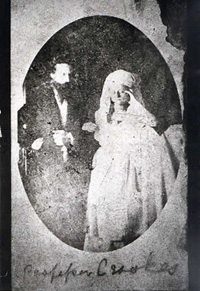
Marryat: “One evening, when she was cutting off pieces of her dress rather lavishly, I remarked that it would require a great deal of mending. She answered, ‘I’ll show you how we mend dresses in the Spirit World.’ She then doubled up the front breadth of her garment a dozen times, and cut two or three round holes in it. I am sure when she let it fall again there must have been thirty or forty holes, and Katie said, ‘Isn’t that a nice cullender?’ She then commenced, whilst we stood close to her, to shake her skirt gently about, and in a minute it was a perfect as before, without a hole to be seen.” (Crookes then asked her to tell about cutting Katie’s hair.)
“She told me to take the scissors and cut off her hair. She had a profusion of ringlets falling to her waist that night. I obeyed religiously, hacking the hair wherever I could, whilst she kept on saying, ‘Cut more! Cut more! Not for yourself, you known, because you can’t take it away.’ So I cut off curl after curl, and as fast as they fell to the ground, the hair grew again upon her head. When I had finished, Katie asked me to examine her hair, to see if I could detect any place, where I had used the scissors, and I did so without any effect. Neither was the severed hair to be found. It had vanished out of sight.”
Part 3, which will discuss the “intelligence” behind the materializations will be posted on December 21.
Michael Tymn is the author of The Afterlife Revealed: What Happens After We Die, Resurrecting Leonora Piper: How Science Discovered the Afterlife, and Dead Men Talking: Afterlife Communication from World War I.
His forthcoming book, No One Really Dies: 25 Reasons to Believe in an Afterlife is released on January 26, 2021.
Read comments or post one of your own
|
|
|
 |
 |
 |
 |
 |
|
|
 |
 |
 |
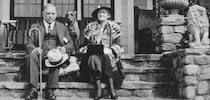 |
 |
| Mackenzie King, London Mediums, Richard Wagner, and Adolf Hitler by Anton Wagner, PhD. – Besides Etta Wriedt in Detroit and Helen Lambert, Eileen Garrett and the Carringtons in New York, London was the major nucleus for King’s “psychic friends.” In his letter to Lambert describing his 1936 European tour, he informed her that “When in London, I met many friends of yours: Miss Lind af Hageby, [the author and psychic researcher] Stanley De Brath, and many others. Read here |
|